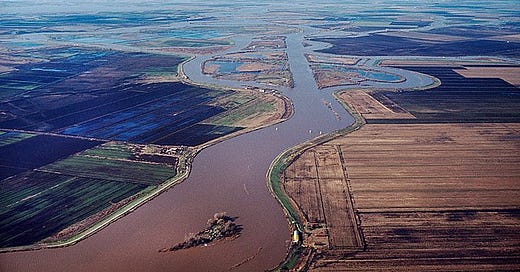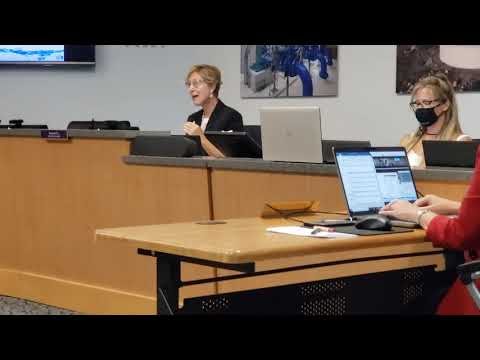[COPY] MWD pushes bankruptcy with Delta support says former state water analyst
His report urges water agencies to replace 'all of the above' business model with a sustainable and equitable system that faces climate-change realities
I’m reposting this interview in two parts to add context to my “We the People” series underway presently. Since it was first posted two years ago SoCal Water Wars has gained thousands of subscribers and followers, many within the past six months, who did not have a chance to read it. — JE
A report released by the non-profit California Water Impact Network says that Gov. Gavin Newsom’s proposed $16 billion Delta Conveyance Project (DCP) could bankrupt the Metropolitan Water District of Southern California (MWD).
Said to be the largest water wholesaler in America, MWD supplies 26 agencies serving 19 million residents of Southern California with water from the State Water Project (SWP—from northern California) and the Colorado River Aqueduct (CRA).
Currently, it sells about 1.5 million acre-feet of water per year to those agencies, storing, treating, and delivering it through an infrastructure network that covers 5,200 square miles in six counties.
It also contributes to water efficiency (conservation) rebate programs and local water-supply projects.
MWD employs about 1,900 full-time employees whose work is supplemented by private contractors, including engineers, consultants, and lobbyists.
Currently it pays for all that with a $2 billion yearly budget that carries $3.9 billion in debt.
The report’s conclusions are based largely on planning documents produced by the MWD, but they have financial implications for water agencies throughout Southern California including the San Diego County Water Authority (CWA), the wholesaler for its 24 member agencies.
MWD has pledged up to $11 billion to finance the DCP and has spent “hundreds of millions” planning for it, according to the report’s author, independent consultant Max Gomberg.
“If MWD continues to pursue the DCP,” his report says, “it faces an economically unsustainable future for itself that increases affordability burdens and inequities for the people it serves.”
Gomberg presented the report at a May 9 press conference.
The MWD says that the DCP would protect the Delta and improve water-supply reliability by building a 45-mile tunnel to convey water under the Delta on its way to Central Valley farmers and Southern Californians.
Critics say the project is a boondoggle that would give limited public water supplies to big ag, harm the Delta, and lead to water overuse during climate change.
Newsom’s water portfolio plan prioritizes construction of the DCP and other large-scale water projects as an “every tool in the tool box” approach to water management.
But to Gomberg, the DCP exemplifies the need to change that business model, which is followed by MWD and water agencies throughout Southern California.
For more than a century, that model depended on greed, faith, and technology to generate enough water to power unlimited economic expansion and lavish spending by water agencies.
But Gomberg’s report says that MWD’s business model ignores the 34 percent decline in water sales in MWD’s service area that occurred since 2009 despite population growth.
That decline is due to conservation induced by mandatory and voluntary cutbacks during severe drought, water-efficiency incentives, education through MWD and local agencies, and state guidelines.
The decline is accompanied by falling revenues needed to pay for infrastructure, services, and debt—all of which drive up water rates in order to fill the revenue gap—creating increased financial distress for those who are least able to pay, says the report.
Increased wastewater recycling by MWD and local SoCal agencies will soon create substantial new water supplies that will further reduce the need for imported water conveyed by MWD and CWA.
Pure Water (wastewater recycling) projects in San Diego, East San Diego County, Oceanside, Los Angeles, Carson (MWD), San Fernando Valley, and San Bernardino County will produce 600,000 acre-feet of water a year when fully operational.
A Pacific Institute study shows that SoCal could boost its water supplies by 1.1 million acre-feet by tripling current wastewater recycling amounts.
Current and upcoming agreements between California and Colorado River basin states, on top of likely future cuts in water allotments from the SWP (due to drought and climate change), will also reduce sales.
But MWD is obligated to help pay infrastructure costs for the SWP, whether it needs its water or not, “even as its customers will be increasingly unwilling or unable to pay.”
(Similarly, CWA, which has gone through an even deeper drop in sales than MWD and is in the middle of a budget crisis, is obligated to pay a heavy price for unneeded water from the Colorado River and the Carlsbad ocean desalination plant, which make up 90 percent of its supply.)
Despite the continued likelihood of falling water sales, MWD’s Integrated Resources Plan assumes a full rebound by 2028, “a prime example of how MWD’s budgeting process fails to reflect the harsh realities of climate change,” says Gomberg’s report.
The DCP would add greatly to MWD’s existing $287 million annual debt service, 14% of its budget, and pass those costs on to its member agencies and their ratepayers, affecting disadvantaged communities the most.
“If MWD agrees to reimburse DWR (the State Department of Water Resources) for 50% of the projected DCP cost, it would be responsible for covering $8 billion in state debt, more than double MWD’s current debt of $3.88 billion,” the report states.
By 2040, the date that DWR says the project would start delivering, MWD’s water would cost up to $3,000/AF, Gomberg predicts.
Making Changes
Creating a sustainable and equitable system, says Gomberg, means adopting new ways of managing water throughout Southern California.
“There is no such thing as an economically responsible ‘all of the above’ strategy,” he says. “We face tough choices and a need for leaders willing to make them.”
That means prioritizing fairness and ecological health “over unconstrained agricultural production and lush urban landscapes” and investing more in local water supplies such as conservation, groundwater storage, wastewater recycling, and capturing stormwater.
It also means syncing water budgets to the availability of supplies and changing to “tiered pricing and fair allocations systems.”
To make water more affordable, “the people who use the most, whether that’s residents or businesses, really need to pay their fair share. And water systems need to cut down on unnecessary expenses,” Gomberg told reporters.
“Proposition 218,” he noted, referring to the 1996 ballot initiative that ties water rates to actual cost of services (and has been used to block tiered water rates), “is not an excuse for inaction.”
The price of water has outpaced all other cost of living indicators by at least twice as much in the last 50 years, Gomberg said. “Unless there is a willingness of political leadership to do something about that, people are going to get hurt.”
The state’s ratepayer assistance program, initiated during the pandemic, is gone and Prop 218 prohibits using ratepayer funds to assist low-income ratepayers who are behind in their bills.
“People are going to get their water disconnected for failure to pay and water systems will not be able to maintain their budgets,” he said. “They [water agencies] are going to lose their credit ratings.”
Noting the crisis in San Diego County over CWA’s proposed rate increases (currently around 10 percent), Gomberg said the high price of water in SoCal isn’t going to change.
“It’s not something that can be solved just locally,” he said. But local and regional water agencies can “take a close look at their business model, what they’re paying for their debt loads, their rate structures—and make equity a priority.”
In fact, more water agencies are using a tiered rating structure. Like the Las Virgenes Municipal Water District in Calabasas, which serves a lot of wealthy ratepayers in the San Fernando Valley.
“They’re saying we’re no longer going to let the water wasters use as much as they want without consequences,” Gomberg was pleased to note.
*Gomberg worked under Govs. Jerry Brown and Gavin Newsom as a conservation manager for the State Water Board. He resigned last year to protest Newsom’s climate change policies, which he says are inadequate.
Related stories:






